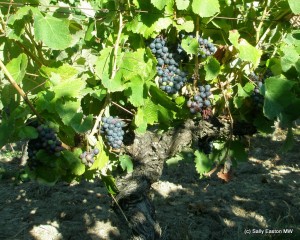Je négrette rien

Négrette
Négrette is the signature cultivar of Fronton, located not far from Toulouse, in south west France.
It’s pretty vigorous and productive so needs reining in. It can make very good wine when yields are in check and winemaking is attentive.
In the small appellation of Fronton (just 2,400 hectares), négrette must comprise at least 40% of the blend, and it can be up to 100%. The other main cultivars allowed are syrah, malbec, braucol, gamay, cabernet franc and cabernet sauvignon.
Its name means ‘black’ and it is indeed a black cultivar, and one that is deeply coloured, with middling acidity, and not always with an accompanying weight of tannin, hence blending with cultivars of greater backbone. Violet is the floral descriptor of choice, and fruit flavours are often to the fore, typically including blackberry and blackcurrant, sometimes with savoury charcoal, black pepper or liquorice notes.
Only red and rosé wines are made in Fronton, with rosé accounting for about a third of total production.
It’s not a variety that is much seen outside of Fronton, let alone outside of France, though California has a small enclave, and Argentina has a touch.
Tasting notes, in situ, September 2013
Château Plaisance, Rosé 2012, Fronton
80% négrette, 20% gamay. 12.5%.
Salmon pink colour. Fresh attack, nice density and smooth texture, dried strawberry notes with hints of black pepper, lovely balance. Vg.
Château Montauriol, Tradition, 2012, Fronton
60% négrette, 20% cabernet franc, 20% syrah
Blackberry, blackcurrant, light tannins, juicy, medium-bodied, thread savoury charcoal, with supple and soft tannins in well balanced whole. Good intensity of dark berry fruited flavours. Good.
Château Boujac, Kélina 2012, Fronton
100% négrette. 12.5%. Fermented in 5-6 year old open barrels and pressed to tank for 6-8 months. Bright cherry red fruits, fresh, light tannins with good concentration and purity of fruit, which has decent substance and smooth texture. Tannins are light and present. Good.
My visit to south west France was sponsored by the Interprofession des Vins du Sud-Ouest (IVSO).



